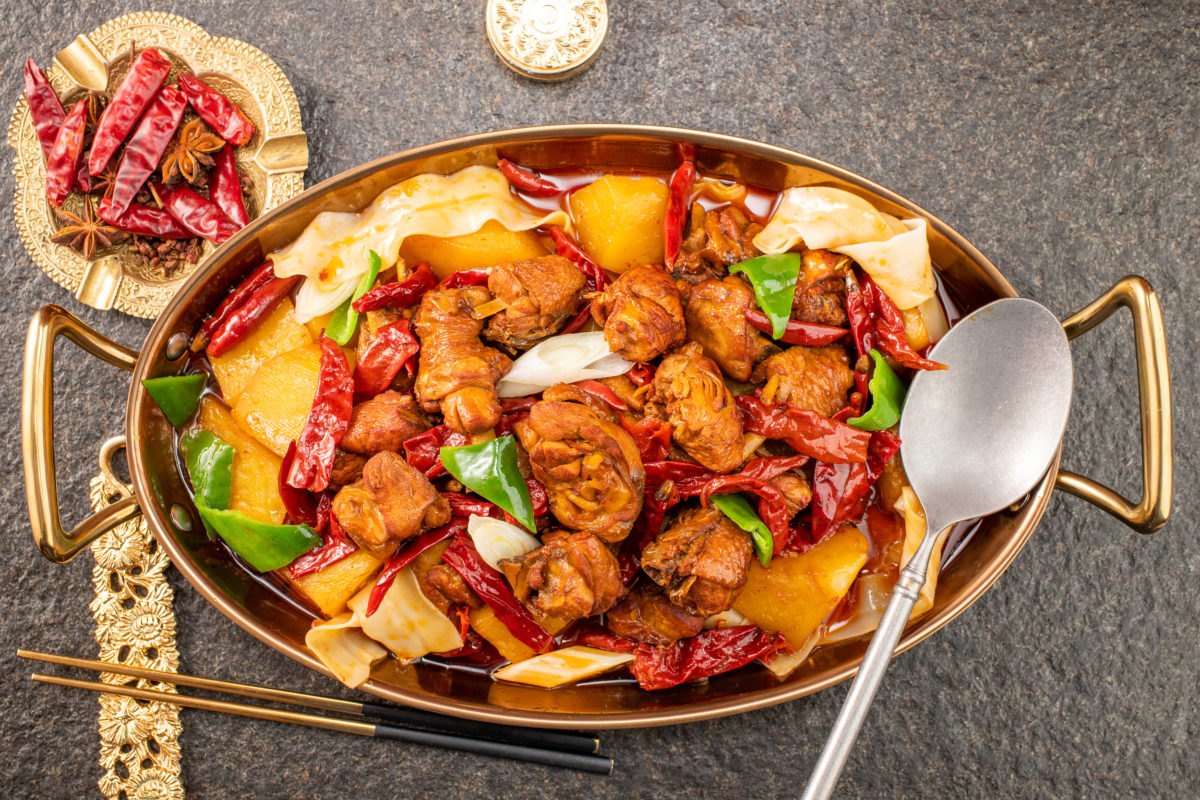Cosmopolitan Roots: The Silk Road Melting Pot
Born along the ancient Northern Silk Road corridors where Han Chinese, Uyghur, Kazakh, and Hui culinary traditions collided, Da Pan Ji (大盘鸡, “Big Plate Chicken”) embodies gastronomic globalization centuries before the term existed. Its 1980s genesis in Shawan County’s truck-stop kitchens speaks to necessity: Xinjiang’s long-haul drivers needed hearty, scalable meals that could withstand desert temperature swings. Cooks improvised using locally abundant ingredients—free-range chickens from the Tian Shan foothills, dried Hunan chilies traded by migrant workers, Gansu-grown potatoes, and Xinjiang’s famed golden onions caramelizing into sweetness against the region’s mineral-rich rapeseed oil. This accidental fusion created what food historian Li Zhonghua calls “communal sustenance architecture“—a dish where Turkic spice alchemy (star anise, Szechuan peppercorns) marries Han braising techniques in cast-iron guo woks.
Culinary Anatomy: Deconstructing the Layered Masterpiece
The Protein Matrix: Beyond Simple Chicken
True Da Pan Ji rejects factory poultry. Uyghur cooks insist on 2-kilogram herb-fed chickens, their collagen-rich bones and dark meat sustaining structural integrity during 40-minute braising. The bird is cleaved into 12–15 bone-in chunks—a practice derived from Islamic zabiha butchery ensuring maximum surface area for spice adhesion. Crucially, skin remains attached, crisping into flavor conduits that later melt into the sauce.
Symphonic Vegetables: More Than Backing Players
- Potatoes: Cut into irregular wedges, they absorb chilies’ heat while releasing starch to thicken the broth during the final 15 minutes of cooking
- Bell peppers: Introduced via Soviet Xinjiang in the 1950s, their charred edges provide smoky counterpoints to numbing peppercorns
- Onions: Locally called piyaz, layered in three stages (aromatics, mid-cook, garnish) to build sweetness without disintegration
The Liquid Gold: Spice Alchemy
The sauce’s complexity arises from tiered infusion:
- Initial bloom: Toasted cumin seeds and sand-thorn berries in smoking oil
- Mid-fry paste: Fermented bean paste (doubanjiang) crushed with garlic
- Deglazing liquid: Xinjiang black beer or Uyghur tea replacing water
This creates a triple-layered umami foundation supporting the dish’s fiery crimson hue.
Cultural Cartography: A Dish as Social Contract
Communal Rituals and Spatial Politics
Served on platters up to 70cm wide, Da Pan Ji demands collective participation. Its consumption follows unspoken protocols:
- Center-peripheral zoning: Chicken reserved for elders at the table’s symbolic “north” position
- Bread-sauce dynamics: Hand-torn nan bread used to scrape the plate, preventing waste
- Noodle integration: Late-addition laghman noodles soak up remnant sauces, transforming leftovers into a second meal
These acts reinforce Uyghur values of resourcefulness and intergenerational reciprocity.
Geopolitical Palate: Edible Borderlands
The dish’s evolution mirrors Xinjiang’s identity negotiations:
- 1989 Variation: Kashgar vendors added Tibetan wild morels during Sino-Tibetan trade openings
- 2008 Innovation: Han chefs in Ürümqi substituted pork belly amid government-subsidized pork campaigns
- 2020s Global Shift: London versions use halal chicken with goji berries, catering to diaspora nostalgia
As anthropologist Dilnur Reyhan notes, “The potato-chicken ratio becomes a barometer of cultural assimilation pressures.”
Contemporary Transformations: From Truck Stops to Fine Dining
Haute Cuisine Reinterpretations
Michelin-starred chefs now dismantle and reassemble Da Pan Ji’s elements:
- At Shanghai’s Ultraviolet: Sous-vide chicken skin stuffed with potato foam, served with Szechuan pepper air
- London’s Silk Road Club: Deconstructed “Da Pan Ji” tartare with minced yak meat and pickled chili gel
- Almaty’s Fusions: Horsemeat replacing chicken, nodding to Kazakh nomadic traditions
The Home Kitchen Renaissance
Home cooks drive digital-age innovations through social media:
- Douyin viral hacks: Instant Pot pressure cooking reducing braising time by 65%
- Sustainability twists: Jackfruit substituting chicken in vegan versions, gaining 2.1M views under #ecodapanji
- Global pantry adaptations: Korean gochujang replacing doubanjiang in Brooklyn apartment kitchens
Preservation and Future: Culinary Heritage in Flux
Amid rapid urbanization, Xinjiang’s government now recognizes Da Pan Ji as intangible cultural heritage, funding documentary projects like “The Last Wok Masters of the Taklamakan.” Yet as Shawan’s original 1980s chefs age, their apprentices face dilemmas: how to automate wok wok hei (breath of the wok) in commercial kitchens without losing the charred poetry of open-fire cooking? Perhaps the answer lies in chef Zeynap Abdulla’s Ürümqi test kitchen, where she calibrates industrial pressure cookers using infrared thermometers while singing Uyghur ballads to the stew—a fusion of ancestral instinct and algorithmic precision, much like the dish itself.

